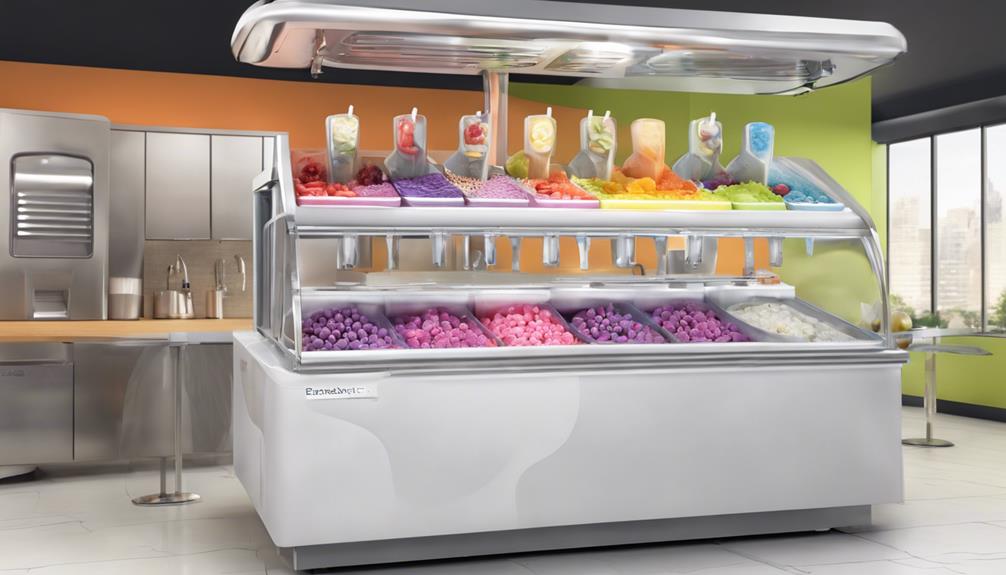Did you know that by the mid-1980s, frozen yogurt had captured over 10% of the frozen dessert market in the United States? If you’re curious about how this popular treat came to be, you’ll find its roots in New England during the 1970s. Initially marketed as a healthier alternative to ice cream, it quickly gained traction among a health-conscious public. The establishment of early franchises, like Everything Yogurt in New York City, played a significant role in its nationwide popularity. But what exactly drove this rapid adoption, and how did the market evolve?
Key Takeaways
- Frozen yogurt emerged in the 1970s in New England.
- It was presented as a low-fat alternative to ice cream.
- Brighams Ice Cream Shop in Boston was pivotal in its conceptualization.
- Everything Yogurt’s rapid expansion in NYC helped popularize frozen yogurt.
- Chains like TCBY and Pinkberry drove flavor innovations and market growth.
Early Beginnings

In the 1970s, frozen yogurt, colloquially known as ‘froyo’ or ‘frogurt,’ emerged in New England as a low-fat alternative to traditional ice cream. This novel dessert was crafted from a mixture of milk and yogurt, distinguishing itself from the cream-laden ice cream that had long dominated the market. The introduction of frozen yogurt in New England marked a significant shift in the frozen dessert landscape of the United States.
Years ago, New England’s health-conscious consumers quickly embraced frozen yogurt for its lighter composition. The absence of heavy cream made it easier on the stomach, a notable advantage over traditional ice cream. This innovation resonated with a growing demographic that prioritized healthier eating habits. Frozen yogurt’s New England roots played a pivotal role in its initial reception and subsequent proliferation.
New York, a hub for culinary trends, soon witnessed the spread of frozen yogurt. The dessert’s appealing taste and perceived health benefits fueled its popularity, leading to a rapid expansion beyond its New England origins. As the first significant low-fat alternative to ice cream, frozen yogurt laid the groundwork for a burgeoning market. Its success underscored a broader shift towards healthier dessert options in the United States.
Invention in New England
The invention of frozen yogurt in New England during the 1970s marked a groundbreaking moment in the frozen dessert industry, offering a revitalizing, low-fat alternative that catered to the burgeoning health-conscious demographic. Frozen yogurt was first conceptualized as a softer and lighter substitute to traditional ice cream, aligning with the era’s increasing emphasis on health and wellness. Brighams Ice Cream Shop in Boston played a pivotal role in popularizing the first frozen yogurt, contributing greatly to its widespread appeal across New England and beyond.
The emergence of frozen yogurt shops in this region not only introduced a novel dessert option but also reflected the England Roots Of Frozen yogurt’s evolution. As consumers began to seek out healthier indulgences, the popularity of frozen yogurt soared, firmly establishing it as a staple in the frozen dessert market. The first frozen yogurt shops and chains, such as Everything Yogurt, quickly capitalized on this growing trend. These establishments provided a variety of flavors and toppings, making it easy for people to love frozen yogurt. New England’s innovation set the stage for a nationwide frozen yogurt craze that continues to thrive today.
First Franchises

As frozen yogurt gained momentum in New England, the establishment of Everything Yogurt in New York City during the late 1970s marked the inception of the first significant franchise, setting the stage for its nationwide proliferation. The success of Everything Yogurt, which quickly expanded to over 200 locations, was instrumental in driving the dessert’s popularity throughout the 1980s. This franchise model made frozen yogurt more accessible, thereby increasing its availability across the United States.
Simultaneously, Brighams Ice Cream Shop in Boston played a vital role in the early promotion and distribution of frozen yogurt. By introducing frozen yogurt alongside traditional ice cream offerings, Brighams catalyzed consumer interest and helped solidify the dessert’s place in American culture. The collaboration between small shops and larger franchises allowed for a robust distribution network that enhanced the dessert’s reach and visibility.
Key milestones in the rise of frozen yogurt franchises include:
- Everything Yogurt’s establishment in New York City
- Rapid expansion to over 200 locations
- Brighams Ice Cream Shop’s role in Boston
- Increased availability and consumer exposure
- Foundation for widespread adoption in the 1980s
Such early efforts laid the groundwork for the dessert’s enduring popularity and set the stage for its eventual nationwide acclaim.
Nationwide Popularity
During the 1980s, frozen yogurt emerged as a nationwide phenomenon, primarily driven by its appeal as a low-fat alternative to traditional ice cream. This rise in popularity was greatly bolstered by pioneering frozen yogurt chains like TCBY, which not only spearheaded flavor innovations but also made frozen yogurt a household name. By the 1990s, the yogurt industry had captured 10% of the frozen dessert market, reflecting its broad appeal.
The advent of chains like Pinkberry in 2005 marked a resurgence in the 21st century, further diversifying the variety of flavors and variety of toppings available to consumers. This renaissance paved the way for the market’s projected $2.1 billion revenue by 2019.
Next time you visit a frozen yogurt shop, you’ll notice the extensive range of options, a reflection of the yogurt industry’s evolution. Here’s a quick overview of some key milestones in the rise of frozen yogurt:
| Year | Event |
|---|---|
| 1980s | Frozen yogurt gains popularity as a low-fat alternative to ice cream |
| 1981 | TCBY, the first frozen yogurt chain, is founded |
| 1990s | Frozen yogurt captures 10% of the frozen dessert market |
| 2005 | Pinkberry’s debut sparks a frozen yogurt renaissance |
| 2019 | Market projected to reach $2.1 billion in revenue |
This historical journey underscores the dynamic nature of frozen yogurt’s nationwide popularity.
Market Fluctuations

While frozen yogurt’s nationwide popularity soared through the 1980s and witnessed a renaissance in the mid-2000s, the industry has also faced significant market fluctuations, characterized by cyclical rises and declines in consumer interest. These cycles in popularity have often been influenced by evolving consumer preferences, competitive landscape, and innovative trends.
The resurgence of frozen yogurt in 2005, with brands like Pinkberry and Red Mango, marked a significant upward trend. However, by the 2010s, many of these brands faced challenges as the market cooled, leading to numerous closures. Understanding these fluctuations is essential for businesses aiming to thrive in the competitive frozen yogurt market.
Key factors influencing market cycles include:
- Flavor innovations: New and unique flavors can spark renewed interest.
- Social media promotion: Effective use of social media platforms can drive trends.
- Consumer preferences: Health-conscious trends can either boost or diminish frozen yogurt’s appeal.
- Technological advancements: Improvements in production and distribution can impact market dynamics.
- Regional preferences: Tailoring products to local tastes is vital for sustained success.
Navigating these market fluctuations requires a keen understanding of trends, competition, and consumer behavior, ensuring that businesses can adapt and flourish in an ever-changing market landscape.
Frequently Asked Questions
Where Did Frozen Yogurt Originate?
You’re curious about where frozen yogurt originated. It’s rooted in ancient recipes and sweet traditions, evolving through dairy innovations. Yogurt pioneers in New England sparked its dessert evolution, leading to global influences and flavor experiments.
Why Did Frozen Yogurt Get Popular?
You’re wondering why frozen yogurt got popular? It’s due to health benefits, flavor trends, innovative marketing strategies, and celebrity endorsements. Social media amplified seasonal demand and customer preferences, driving its widespread appeal.
Is Frozen Yogurt Healthier Than Ice Cream?
Frozen yogurt’s typically healthier due to lower calorie count, reduced fat levels, and beneficial probiotics. However, it’s important to take into account sugar content, ingredient quality, and serving sizes. Additionally, it’s often better for lactose tolerance compared to ice cream.
Are Cultures Still Alive in Frozen Yogurt?
Imagine a garden of beneficial bacteria blooming in your gut. Yes, frozen yogurt still contains live probiotics. These bacterial cultures, resulting from yogurt fermentation, remain active, offering gut health, microbiome benefits, and the unique properties of yogurt strains.
Conclusion
To sum up, you’ve witnessed how frozen yogurt, making its debut in New England during the 1970s, evolved from a niche health-conscious treat into a nationwide sensation. The early franchises, such as Everything Yogurt, paved the way for its widespread popularity, similar to how the internet revolutionized communication. Despite market fluctuations, the allure of froyo remains strong, reflecting a persistent zeitgeist for healthier dessert options. This journey highlights the dynamic interplay between culinary innovation and consumer trends.







